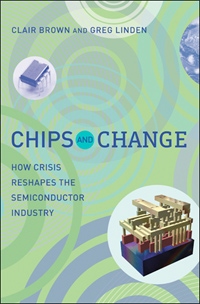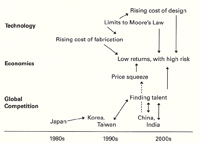 I’ve been reading an interesting book on the semiconductor industry. It’s called Chips and Change by Clair Brown and Greg Linden. I got sent a review copy (there are some tiny advantages to being a blogger) and I’m not sure whether it is truly available. Amazon shows it as having a publishing date of 9/30 but also being in-stock with a delay. Anyway, if you have anything to do with semiconductors I recommend you buy a copy immediately.
I’ve been reading an interesting book on the semiconductor industry. It’s called Chips and Change by Clair Brown and Greg Linden. I got sent a review copy (there are some tiny advantages to being a blogger) and I’m not sure whether it is truly available. Amazon shows it as having a publishing date of 9/30 but also being in-stock with a delay. Anyway, if you have anything to do with semiconductors I recommend you buy a copy immediately.
The book looks at semiconductor as an economic issue rather than from a technological point of view (although this is not ignored) which fits in with my view of the world. Semiconductor process transitions are driven by economics (cheaper transistors) more than technology (better transistors) especially now where leakage and other considerations make it unclear whether you are getting better transistors or only more of them.
The book examines how the semiconductor industry has lurched between major crises that has driven both its success and its restructuring over time. It starts back in the 1980s when the US, having essentially invented the integrated circuit, started to lose the quality war to Japan. It examines 8 crises in total.
First, losing the memory quality war to Japan that eventually drove most US memory supplies (Intel, for example, remember they were a memory supplier) out of the market. Most readers probably don’t remember when HP announced how much better the quality of Japanese memories was compared to American, and how it shook the industry to the core (they had lots of data).
The second crisis was the rising cost of fabrication. The result of this in the US (but not elsewhere) was the creation of fabless semiconductor companies that used TSMC, UMC and Chartered to manufacture. Also the creation of clubs of companies sharing the cost of process development.
The third crisis was the rising cost of design. This meant that low volume products just were not economically viable. Chips used to be consumed by big corporations largely insensitive to price to consumers who were hyper-sensitive to price. This was the fourth crisis. Somewhere in here the FPGA started to play a role.
The fifth crisis was the limits to Moore’s law, in particular limitations in lithography (Moore’s law is more about lithography than any other aspect of semiconductor manufacture). This has been an ongoing issue forever, of course, but has started to become the fundamental limitation on progress.
As the number of people involved in a design, and their cost, increased out of control there was a rush to find new talent in India and China. Partially for cost reasons but also because there were too few designers available without looking globally.
But fabs got more and more expensive, and price pressure on end-products got more intense leading to the current situation where most companies cannot afford to build a fab nor develop a leading edge process to run within it. There are just 4 or 5 groupings now that can do this (Intel, Samsung/IBM/ST, TSMC, Japan, UMC/TI) and there is likely to be further consolidation. Even with tapping into low cost Asian labor , semiconductors are not getting the share they feel they should of the electronics value chain.
The 8th challenge is the new level of global competition. Japan is clearly, for example, losing out as a “Galapagos market” with lots of internal competition but, as I’ve said before, turning their back on the world, just like how the Galapagos produced giant tortoises. But also there is governmental competition with states attempting to join the industry keeping global competition feverish.
 The book has a great graphic that summarizes the change in the basis of competition over time. If you read from left to right you see the problems come up chronologically. The vertical scale splits them into technological problems, economic problems, and competitive/globalization issues. This single graphic pulls together all of the issues facing the semiconductor industry, and how it got here, in a single simple chart.
The book has a great graphic that summarizes the change in the basis of competition over time. If you read from left to right you see the problems come up chronologically. The vertical scale splits them into technological problems, economic problems, and competitive/globalization issues. This single graphic pulls together all of the issues facing the semiconductor industry, and how it got here, in a single simple chart.
As I said earlier, if you are involved in the challenges of the semiconductor industry, this is a book you should read (and, in case anyone is suspicious, I’m have no relation with the publisher other than receiving a free copy).
